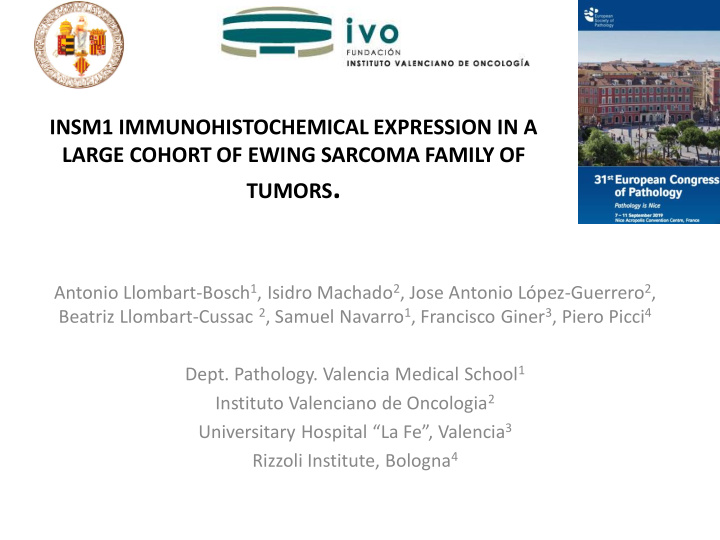



INSM1 IMMUNOHISTOCHEMICAL EXPRESSION IN A LARGE COHORT OF EWING SARCOMA FAMILY OF TUMORS . Antonio Llombart-Bosch 1 , Isidro Machado 2 , Jose Antonio López-Guerrero 2 , Beatriz Llombart-Cussac 2 , Samuel Navarro 1 , Francisco Giner 3 , Piero Picci 4 Dept. Pathology. Valencia Medical School 1 Instituto Valenciano de Oncologia 2 Universitary Hospital “ La Fe ” , Valencia 3 Rizzoli Institute, Bologna 4
INSM1 IMMUNOHISTOCHEMICAL EXPRESSION • INSM1 (insulinoma-associated protein 1), also known as zinc-finger protein IA-1, is a developmentally regulated zinc-finger transcription factor. • It localizes to the nucleus and is expressed in embryonic tissues undergoing neuroendocrine differentiation. Mapping to 20p11.23 chromosome. • INSM1 is not present in normal adult tissues, but can be found highly expressed in neuroendocrine tumors. Rosenbaum, J.N., et al. 2015. Am. J. Clin. Pathol. 144: 579-591.
INSM1 IMMUNOHISTOCHEMICAL EXPRESSION • Its expression has been tested in limited series of Ewing sarcoma family of tumors (ESFT). • Given the potential neuroendocrine differentiation in ESFT, we aimed to determine INSM1 expression in a large series of genetically- confirmed ESFT. • As a control we used a cohort of tumors with well-known neuroendocrine differentiation.
UNDIFFERENTIATED NEUROBLASTOMA H/E H/E CD99 NB84
ES: HISTOLOGICAL SUBTYPES ( Conventional, PNET ) *Llombart-Bosch A, Machado I, Navarro S, Bertoni F, Bacchini P, Alberghini M, Karzeladze A, Savelov N, Petrov S, Alvarado-Cabrero I, Mihaila D, Terrier P, Lopez-Guerrero JA, Picci P. Histological heterogeneity of Ewing's sarcoma/PNET: an immunohistochemical analysis of 415 genetically confirmed cases with clinical support. Virchows Arch. 2009 Nov;455(5):397-411.
IMMUNOHISTOCHEMISTRY: TESTED ANTIBODIES Llombart, A et al. Prothets consortium Roma 2013 MOLECULAR TARGETS DIAGNOSTIC CELL CYCLE/PROGNOSIS C-KIT CD99 P53,P14, P16 EPO EPOR HNK1 P21, P27 GSCF FLI1/ERG KI67 (MIB 1) GSCFR IGFR1a CAVEOLIN 1 NEUROENDOCRINE MARKERS CHROMOGRANIN NKX2.2 SYNAPTOPHYSIN MOLECULAR PATHWAYS b -CATENIN CCN3 EPITHELIAL SNAIL K19 DIFFERENTIATION SLUG NH2 GSK-3 b CK, EMA, CEA NH3 AKT E-CADHERIN PI3K NH4 OCCLUDIN WNT NH5 ZO-1 NOTCH DESMOPLAKIN
IMMUNOHISTOCHEMISTRY ES : CD99, CAVEOLIN, NXK2.2 CD99 CD99 CAV-1 NKX2.2
IMMUNOHISTOCHEMISTRY ES . NEURAL AND NEUROENDOCRINE MARKERS Synaptophysin:14% Chromogranin: 7% S100 Synaptophysin Chromogranin Machado I, Yoshida A, López-Guerrero JA, Nieto MG, Navarro S , Picci P, Llombart-Bosch A . Immunohistochemical analysis of NKX2.2, ETV4, and BCOR in a large series of genetically confirmed Ewing sarcoma family of tumors. Pathol Res Pract. 2017, 213:1048-1053
NEUROSECRETION: PNET
NEUROSECRETORY GRANULES: PNET
Modern Pathology (2018), 1 – 9
Modern Pathology (2018), 1 – 9
INSM1 IMMUNOHISTOCHEMICAL EXPRESSION: STUDY CASES • 433 ESFT • 54 Merkel Cell Carcinomas (MCC) • 97 Synovial sarcomas (SS) • 28 Solitary fibrous tumor (SFT) • 200 GIST • 13 Extraskeletal myxoid chondrosarcomas (EMC).
INSM1 IMMUNOHISTOCHEMICAL TECHNIQUE • Antibody SANTA CRUZ BIOTECHNOLOGY, INC. INSM1 (A-8): sc-271408 • Technical procedure • Immunohistochemistry: paraffin-embedded sections • Dilution: 1:50. Pancreas (positive control)
INSM1 IMMUNOHISTOCHEMICAL EXPRESSION • Nuclear staining of moderate/strong intensity in at least 5% of tumor cells was considered positive neg ++ +++
INSM1 IMMUNOHISTOCHEMICAL EXPRESSION: RESULTS POSITIVITIES - 100% MCC nuclear diffuse and strong intensity - 61% ESFT nuclear strong or focal intensity - 70% EMC nuclear diffuse or low intensity - 21% SFT nuclear low intensity - 2% SS occasional focal intensity - 0.5% GIST very occasional Cases were evaluated independently by two pathologists: (ALLB, IM)
INSM1 IMMUNOHISTOCHEMICAL EXPRESSION: RESULTS • MERKEL CELL CARCINOMA CASES: 54/54 positive pospositive +++ +++ +++
INSM1 IMMUNOHISTOCHEMICAL EXPRESSION: RESULTS • EWING SARCOMA CASES: 433/ 263 positive neg ++ +++
INSM1 IMMUNOHISTOCHEMICAL EXPRESSION: RESULTS • EWING SARCOMA CASES: 433/263 positive Staining was not correlated with the histological subtypes of srct
INSM1 IMMUNOHISTOCHEMICAL EXPRESSION: RESULTS • EXTRASKELETAL MYXOID CHONDROSARCOMA: 13/9 positive neg ++ +++
INSM1 IMMUNOHISTOCHEMICAL EXPRESSION: RESULTS • SOLITARY FIBROUS TUMORS: 28/6 positive ++
INSM1 IMMUNOHISTOCHEMICAL EXPRESSION: RESULTS • SYNOVIAL SARCOMAS: 97/2 positive neg ++
INSM1 IMMUNOHISTOCHEMICAL EXPRESSION: RESULTS • GASTROINTESTINAL STROMAL TUMORS: 200/1 positive neg ++
INSM1 IMMUNOHISTOCHEMICAL EXPRESSION: CONCLUSION • INSM1 expression in ESFT is higher than described previously, nevertheless this finding does not distinguish these tumors from other “ small round cell tumors ” (SRCT) such as MCC, EMC or SS that may show focal or diffuse staining for this marker. • Therefore, INSM1 immunoreactivity should be interpreted within a specific clinicopathological context. • Strong and diffuse INSM1 expression in cutaneous SRCT, strongly supports the possibility of MCC, but in soft tissue/bone tumors this immunoreactivity may not exclude a metastatic neuroendocrine tumor, EMC or ESFT. • New studies are underway to check the prognostic significance of this marker as well as the already-confirmed neuroendocrine differentiation of ESFT.
VALENCIA: CITY OF ARTS AND SCIENCES THANK YOU FOR YOUR ATTENTION
Recommend
More recommend